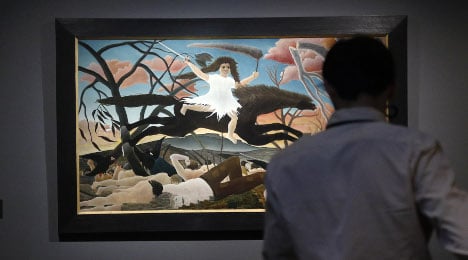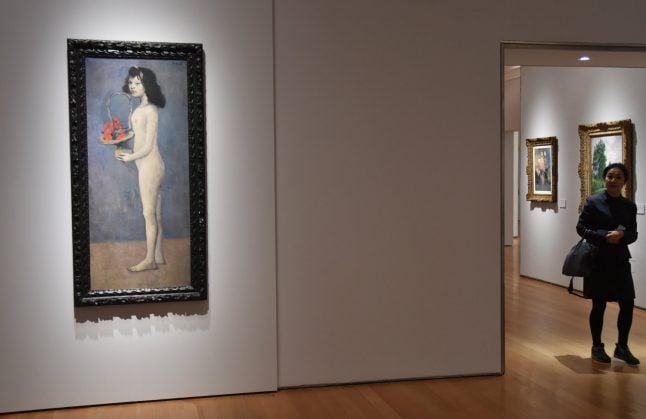An unreconstructed libertine who made debauchery into high art or a vile pornographer who tried to justify rape, murder and paedophilia?
From Flaubert to Baudelaire, the influence of the Marquis de Sade on writers is well documented, but a new exhibition in Paris sets out to explore how the 18th-century nobleman has also influenced artists over the past two centuries.
A 52-second video promoting the exhibition at Paris' Musee d'Orsay shows writhing naked bodies, some apparently biting and crying out in pain.
It is, however, no preparation for the real horror depicted in many of the works on display such as headless bodies and torture.
The museum – which last year staged a wildly successful show called "Masculin/Masculin" on male nudes with no shortage of frontal nudity – even issued a disclaimer for the Sade exhibit.
"The violent nature of some of the works and documents may shock some visitors," its website says.
The "connection he (Sade) found between desire and ferocity, which in his eyes, is inherent in man, completely haunts art," Sade expert and joint curator of the exhibition, Annie Le Brun, told AFP.
Sade's notoriety rests on his novel "The 120 Days of Sodom" about sexual depravity, murder and paedophilia.
The novel – a draft of which was written in 1785 while Sade was being held in Paris' Bastille prison – details the sexual orgies of four wealthy French libertines who rape, torture and finally murder their mostly teenage victims.
The late US feminist writer Andrea Dworkin in 1985 called Sade the "world's foremost literary pornographer" and condemned the practice of approaching "pornography as if it were an intellectual phenomenon".
According to Le Brun and co-curator Laurence des Cars, however, the exhibition looks at the extent to which Sade "steeped in rebellion, encouraged the representation of what cannot be said" in art.
'Literary pornographer'
"He sets us a new challenge, raising the issue of what defies representation by establishing its connection with both the freedom to say everything and individual freedom," they said.
Described by Sade (1780-1814) as "the most impure tale that has ever been told since our world began", his novel was officially suppressed and difficult to obtain during the 19th century.
Before it was finally published in 1904, it was read clandestinely by many 19th century writers — including "Madame Bovary" author Gustave Flaubert and poet Charles Baudelaire.
"Sade, Attacking the Sun" comes as Sade is about to be introduced to a new generation. Next month in France Ubisoft will release a video game based on
Sade, a follow-up to the French Revolution-set "Assassins Creed" series.
The exhibition delves into the influence Sade exerted over artists such as Eugene Delacroix, Edgar Degas, Francis Bacon, Jean-Auguste-Dominique Ingres and Pablo Picasso.
Le Brun and des Cars, an expert in 19th century art, said that although Sade did not discover "violence in love" or invent "sadism", he did make it "one of the abiding themes in a process of dramatising the erotic".
'Murder and sexuality'
Examples in the exhibition include "Scene of War in the Middle Ages" by Degas in which the artist depicts naked women cowering or left for dead by three horsemen.
By juxtaposing the beauty of the female body and the horror of violence, Degas "was putting into images the ambiguous relationship that can exist between murder and sexuality" as first formulated in Sade's writings, according to the curators.
In another work, "Death of Sardanapalus" by Eugene Delacroix, rebels beseige him in his palace.
From his place on top of an enormous pyre, Sardanapalus orders his slaves and palace officers to cut the throats of his women, pageboys and favourite horses and dogs.
"None of the objects that had served his pleasure could survive" in an annihilation of everything he had loved "similar to the murderous pleasure Sade described", they said.
Twentieth-century artists featured Picasso and Bacon.
In Picasso's "The Rape of the Sabine Women", a woman and child are trampled beneath the hooves of a soldier's horse.
According to Le Brun and des Cars, even the horse "appears to be smiling a smile that appears to be sadistic".
The word "sadism", based on Sade's name, first appeared in a French dictionary in 1834.



 Please whitelist us to continue reading.
Please whitelist us to continue reading.
Member comments